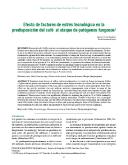| dc.description.abstract | Plantas de café (Coffea arabica) se expusieron a factores de estrés tecnológico para evaluar su influencia en el desarrollo general del cultivo y en su susceptibilidad al ataque de hongos fitopatógenos. Su efecto no se manifestó de manera uniforme en las variables de crecimiento sin embargo, las consecuencias fueron evidentes en algunas de las interacciones. La susceptibilidad al ataque de Fusarium spp. se incrementó cuando las plantas crecieron expuestas a alta luminosidad, presencia de residuos del herbicida diurón en el suelo del almácigo y dosis bajas de fertilización. La incidencia de Phoma costarricensis fue afectada significativamente por la exposición de las plantas al 75 o 100 por ciento de luminosidad y la presencia de residuos de diurón, obteniéndose el porcentaje más alto (76,38 por ciento) cuando se produjo un sinergismo entre el ataque de Fusarium spp. y los efectos de diurón. Se comprobó que al establecer el almácigo bajo el 50 por ciento de sombra, utilizar suelo sin residuos de diurón y aplicar dosis adecuadas de fertilización se reducen las condiciones de estrés para el cultivo, en cuyo caso es mínima la incidencia de Fusarium spp. y P. costarricensis. Coffee (Coffea arabica) plants were exposed to technological stress factors in order to evaluate the way in which they influence the general development of the crop and its susceptibility to attack by phytopathogenic fungi. Their effect on the growth variables was not uniform however, consequences were evident in some of the interactions. Susceptibility to attack by Fusarium spp. increased when the plants were exposed to high light conditions, presence of residues of the herbicide diuron in the potting soil and low doses of fertilizers. The incidence of Phoma costarricensis was significantly affected by exposing the plants to 75 or 100 percent luminosity and the presence of diuron residues, reaching the highest percentage (76.38 percent) when there was a synergism between the attack of Fusarium spp. and the effects of diuron. It was shown that establishing the seedling bed under 50 percent shade, using soil without diuron residues and applying adequate doses of fertilization reduces the stress conditions for the crop and so the incidence of Fusarium spp. and P. costarricensis is minimal. | es_ES |


